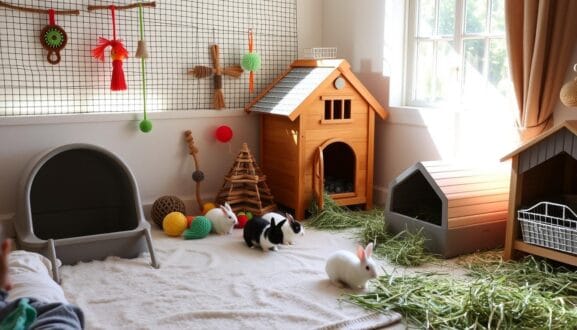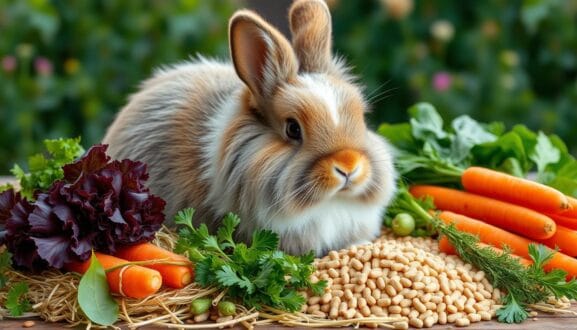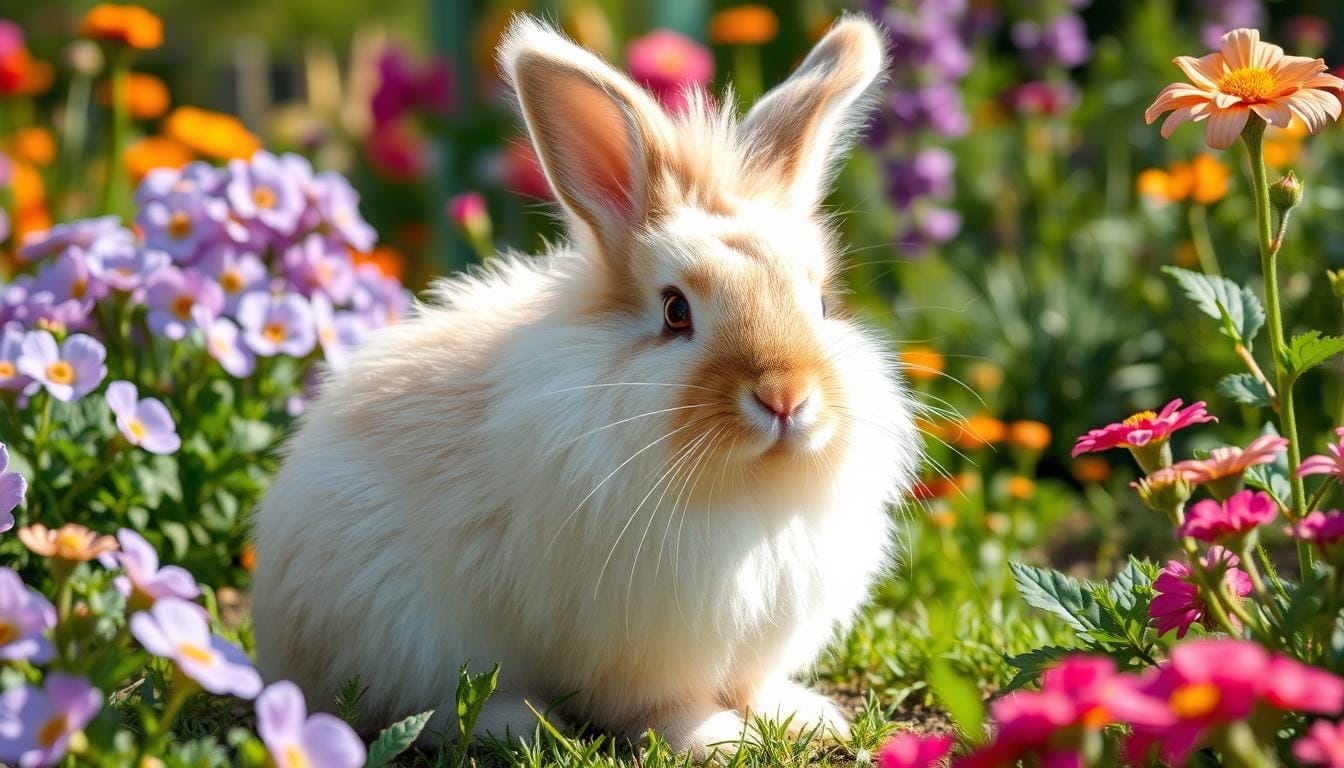Thinking about getting a new pet? The English Angora rabbit might be perfect for you. This breed is known for its soft wool and cute looks. It makes a beautiful and special companion.
Your English Angora rabbit is very gentle. They are calm and friendly, great for families and singles. This makes them easy to get along with.
In this article, we’ll dive into the English Angora rabbit’s history and traits. We’ll also cover their care needs. You’ll learn why they’re a wonderful pet and how to create a great home for them.
- Introduction to the English Angora Rabbit
- Physical Appearance and Wool Production
- Temperament and Personality Traits of English Angora Rabbits
- Essential Housing Requirements
- Grooming and Maintenance Needs
- Dietary Requirements and Feeding Schedule
- Health Considerations for Your English Angora Rabbit
- Exercise and Enrichment Activities
- Cost of Owning an English Angora Rabbit
- Training and Bonding Tips
- Conclusion: Is an English Angora Rabbit Right for You?
- FAQ:
- How much do English Angora rabbits cost?
- Are English Angora rabbits good pets?
- How long do English Angora rabbits live?
- How big do English Angora rabbits get?
- Why is Angora so expensive?
- What are the disadvantages of Angora rabbits?
- What do English Angora rabbits eat?
- What are the key characteristics of English Angora rabbits?
- How often do English Angora rabbits need to be groomed?
- Are English Angora rabbits good with children?
- What are common health issues in English Angora rabbits?
- What costs should I expect when owning an English Angora rabbit?
Introduction to the English Angora Rabbit
The English Angora rabbit is a favorite among rabbit lovers. It’s known for its soft wool and gentle nature. This makes it a great choice for both new and seasoned pet owners.
History of the Breed
The Angora rabbit’s history goes back to the 16th century in Turkey. They were first bred for their beautiful wool. Over time, selective breeding made them into the English Angora we know today.
Distinct Characteristics
English Angoras have a soft, dense coat that needs regular grooming. They are small and round, making them perfect pets. Their big eyes and floppy ears also make them very charming.
Popularity as Pets
The English Angora is loved for its friendly and beautiful nature. They are playful and social, making them great companions. This has made them very popular in homes across the United States.
Physical Appearance and Wool Production
The English Angora has a English Angora appearance that’s both charming and sturdy. They have a compact, muscular body and a rounded head. These rabbits weigh between 4 to 6 pounds, with a sturdy build that supports their luxurious coat.
Their fur is soft, dense, and comes in many colors. You can find them in white, black, blue, and broken patterns. This variety makes them stand out.
One of the English Angora’s best features is their Angora wool. This wool grows continuously and can reach up to 2 inches long. It’s silky and fine, perfect for high-quality textiles.
English Angoras produce a lot of wool every year. This wool is great for crafting projects or even making money for owners.
Proper rabbit fur care is key to keeping their coat in top shape. Regular grooming prevents matting and keeps the wool clean and healthy. By grooming them regularly, you can enjoy their wool while keeping them comfortable.
| Feature | Description |
|---|---|
| Size | 4-6 pounds, compact and muscular |
| Coat Length | Up to 2 inches, continuous growth |
| Colors | White, black, blue, broken patterns |
| Wool Texture | Silky and fine, ideal for textiles |
| Wool Production | High yield annually, suitable for crafts and income |
Temperament and Personality Traits of English Angora Rabbits
Knowing the Angora rabbit’s temperament is key for a happy pet relationship. These rabbits are gentle and loving, making great friends for many families.
Social Nature
Angora rabbits love being around people. They bond well with their owners and enjoy daily interaction. This keeps them happy and friendly.
Interaction with Children
English Angoras are perfect for families with kids. They are patient and gentle, teaching children how to care for pets.
Compatibility with Other Pets
These rabbits get along well with other pets if introduced slowly. Their calm nature helps them live peacefully with other animals.
| Trait | Description |
|---|---|
| Gentle | Calm and easygoing, suitable for households with children. |
| Affectionate | Forms strong bonds with owners and enjoys companionship. |
| Adaptable | Compatible with other pets and various living environments. |
| Playful | Enjoys gentle play and interactive activities. |
Essential Housing Requirements
Creating the right environment is crucial for your English Angora rabbit’s well-being. Proper rabbit housing ensures they remain healthy and happy.
- Space: A minimum of 12 square feet per rabbit is recommended to provide ample room for movement.
- Angora Rabbit Cage: Choose a sturdy cage with high sides to prevent escapes and protect from predators.
- Indoor Rabbit Setup: Ensure the area is well-ventilated, temperature-controlled, and free from drafts.
- Flooring: Opt for materials that are easy to clean and gentle on their long fur, such as linoleum or wood pellets.

While indoor housing offers protection from harsh weather and predators, outdoor enclosures provide more space but require secure fencing. Balance is key to meet your rabbit’s needs.
| Housing Option | Pros | Cons |
|---|---|---|
| Indoor Rabbit Setup | Protected from weather, easy access, better temperature control | Limited space, requires regular cleaning |
| Outdoor Enclosure | More space to roam, natural sunlight | Exposure to elements, need for secure fencing |
Grooming and Maintenance Needs
Keeping your English Angora rabbit clean and healthy is key. A regular grooming routine helps prevent matting and keeps them comfortable.
Daily Grooming Routine
Start with daily brushing to remove loose hair and stop tangles. A soft-bristle brush is best for their coat. It also cuts down on hair around your house.
Wool Collection Methods
It’s important to collect wool from your Angora rabbit. You can do it by plucking or shearing:
- Plucking: This method is gentler on the rabbit and involves removing wool by hand.
- Shearing: Electric shears made for rabbits are quick and easy to use for wool collection.
Seasonal Care Requirements
Adjust your grooming based on the season. Brush more often during shedding seasons. In cold weather, keep their coat thick for warmth.
| Season | Care Tips |
|---|---|
| Spring | Increase brushing to manage shedding |
| Summer | Regular shearing to prevent overheating |
| Fall | Maintain coat thickness with consistent grooming |
| Winter | Ensure adequate insulation by minimizing excessive wool removal |
Dietary Requirements and Feeding Schedule
A proper Angora rabbit diet is key for your pet’s health and their beautiful wool. A balanced diet gives them the best rabbit nutrition and helps their wool grow.
- Unlimited hay, preferably Timothy hay
- Fresh leafy vegetables like spinach and romaine lettuce
- Limited pellets to provide necessary proteins and vitamins

English Angoras need a special feeding schedule because of their wool growth. Here’s a sample feeding plan:
| Meal | Food | Portion Size |
|---|---|---|
| Morning | Hay and fresh greens | Unlimited hay, 1 cup of vegetables |
| Afternoon | Pellets | 2 tablespoons |
| Evening | Hay and fresh greens | Unlimited hay, 1 cup of vegetables |
Always give fresh water and safe treats like small fruit pieces. But, avoid foods high in sugar or toxic to rabbits, like chocolate, onions, and iceberg lettuce.
- Avoid sugary treats and processed foods
- Steer clear of toxic vegetables like onions and potatoes
When adding new foods, do it slowly. Watch your rabbit’s weight and health to make sure they’re okay with the diet changes.
Health Considerations for Your English Angora Rabbit
Keeping your Angora rabbit healthy is key to their happiness and long life. Knowing about common diseases and regular vet visits can help avoid many problems.
Common Health Issues
- Wool Block: A condition where ingested wool forms a blockage in the digestive system.
- Dental Problems: Overgrown teeth can lead to difficulty eating and infections.
- Heat Stress: Thick coats make Angoras susceptible to overheating, specially in warm climates.
Preventive Care
- Provide a balanced diet rich in fiber to aid digestion.
- Regularly groom your rabbit to prevent wool ingestion.
- Maintain a clean and spacious living environment.
- Ensure access to fresh water at all times.
When to Visit the Vet
Watch for signs of illness like loss of appetite, lethargy, or unusual behavior. Early vet visits can solve problems before they get worse.
| Symptom | Possible Issue | Recommended Action |
|---|---|---|
| Loss of Appetite | Dental Problems or Digestive Blockage | Contact a veterinarian immediately |
| Excessive Shedding | Stress or Poor Grooming | Increase grooming frequency and check living conditions |
| Difficulty Breathing | Heat Stress or Respiratory Infection | Provide a cool environment and seek veterinary care |
Exercise and Enrichment Activities
Keeping your English Angora rabbit active is key for its health and happiness. Regular rabbit exercise helps keep a healthy weight and prevents obesity.
Give your rabbit daily chances to move around. Supervised outdoor time lets it explore safely in a secure spot. An indoor play space with tunnels and ramps also encourages activity.
- Supervised outdoor time
- Indoor play areas
- Use of Angora rabbit toys
Keep your rabbit’s mind sharp with pet enrichment activities. Toys that mimic natural behaviors like chewing, digging, and exploring are great. Use items like cardboard boxes, puzzle feeders, and safe chew toys to keep it entertained.
Try making your own tunnels or foraging boxes. These activities are fun and improve your rabbit’s environment.
Make sure to balance exercise with rest, as Angoras can get too hot. Watch your pet to keep it comfortable during play.
Cost of Owning an English Angora Rabbit
Having an English Angora rabbit can be very rewarding. But, it’s key to think about the money side. Planning your budget well helps your pet get the best care without surprise costs.
Initial Setup Expenses
The first costs include buying the rabbit and setting up a cozy home. You’ll also need grooming tools and basic supplies like feeders and bedding. These initial costs can be between $200 and $500, based on the quality and where you buy.
Ongoing Monthly Costs
Every month, you’ll need to buy high-quality hay, fresh veggies, and pellets. You’ll also need to replace bedding often. Plus, regular vet visits are a must. Expect to spend $50 to $100 monthly to keep your Angora rabbit healthy and joyful.
Emergency Fund Considerations
It’s important to save for emergencies in your budget. Unexpected health problems or accidents can happen. Having a fund for vet emergencies helps avoid financial stress. Aim to save $100 to $200 a year for emergencies.
| Expense Category | Estimated Cost |
|---|---|
| Initial Rabbit Purchase | $100 – $300 |
| Housing Setup | $50 – $150 |
| Grooming Tools | $20 – $50 |
| Monthly Food & Supplies | $50 – $100 |
| Veterinary Care (Annual) | $100 – $200 |
| Emergency Fund | $100 – $200 |
Training and Bonding Tips
Training your English Angora rabbit can make your bond stronger and your home happier. Begin with basic rabbit training by introducing a litter box. Place it in a quiet spot and guide your rabbit to use it often.
Use positive reinforcement to encourage good behavior. Give small treats when your rabbit follows commands or uses the litter box right. Remember, patience is key; rabbits learn at their own pace.
Building strong pet bonding means spending quality time together. Gently handle your rabbit every day to build trust. Speak softly and move slowly to make your rabbit feel safe.
Engage in Angora rabbit socialization by introducing your pet to different people and places. This makes your rabbit comfortable and reduces stress in new situations. Give your rabbit stimulating toys and activities to keep them mentally and physically active.
Understanding your English Angora’s unique personality will help your training. Some may be more independent, while others love interaction. Tailor your approach to fit your rabbit’s temperament for a harmonious relationship.
Conclusion: Is an English Angora Rabbit Right for You?
Choosing a pet rabbit is a big decision. It should match your lifestyle and what you can offer. English Angora rabbits are beautiful and loving, making great pets for many families.
Angora rabbits need special care, like regular grooming and lots of space. Think if you can give them the time and effort to keep their wool clean and healthy.
Look at your home to see if it’s safe and fun for a rabbit. It’s also key to make sure everyone in the house gets along with the rabbit.
Think about your daily routine. Can you care for an Angora rabbit every day? These rabbits live a long time and need your love and care.
By thinking about these things, you can decide if an English Angora rabbit is right for you. Making a smart choice will make your pet experience happy and rewarding.
FAQ:
How much do English Angora rabbits cost?
The price of an English Angora rabbit typically ranges from $75 to $250, depending on factors like breeder reputation, lineage, and coat quality. Show-quality rabbits or those with exceptional wool may cost more. Prospective owners should also consider ongoing expenses for grooming, housing, and care to maintain their health and well-being.
Are English Angora rabbits good pets?
The English Angora rabbit makes an excellent pet for those prepared to meet its grooming and care needs. Known for their gentle temperament and affectionate nature, they bond well with attentive owners. However, their luxurious wool requires frequent grooming, making them ideal for dedicated individuals seeking a unique and rewarding companion.
How long do English Angora rabbits live?
An English Angora rabbit has a lifespan of 7 to 12 years with proper care. Their longevity depends on factors like a balanced diet, regular grooming, and a stress-free environment. Providing a clean habitat and routine veterinary check-ups ensures these gentle and unique rabbits thrive throughout their life.
How big do English Angora rabbits get?
An English Angora rabbit typically weighs between 5 and 7.5 pounds when fully grown. Despite their compact size, their dense, woolly coats give them a larger and more majestic appearance. This medium-sized breed is admired for its unique combination of manageable proportions and luxurious, soft fur that requires regular care.
Why is Angora so expensive?
Angora wool, derived from the English Angora rabbit, is expensive due to its labor-intensive harvesting process and luxurious texture. Each rabbit requires meticulous grooming and shearing to produce high-quality fibers. The rarity of Angora wool, combined with its softness and lightweight warmth, contributes to its premium price in the textile market.
What are the disadvantages of Angora rabbits?
An English Angora rabbit requires extensive grooming to prevent matting and wool block, making them high-maintenance pets. Their dense coats can trap debris, increasing the risk of skin infections. Additionally, they are prone to overheating in warm climates and require a cool, well-ventilated environment to maintain their health and comfort.
What do English Angora rabbits eat?
An English Angora rabbit thrives on a diet rich in high-quality hay, such as Timothy or orchard grass, which aids in digestion and prevents wool block. Fresh vegetables, like leafy greens, and a limited amount of rabbit pellets supplement their nutrition. Access to fresh water ensures their overall health and vitality.
What are the key characteristics of English Angora rabbits?
English Angora rabbits have long, soft wool and are very gentle. They have big, expressive eyes and a fluffy look. They come in many colors, making them beautiful to look at. They also love people and make great pets.
How often do English Angora rabbits need to be groomed?
English Angora rabbits need to be groomed every day. This keeps their fur from getting tangled and keeps it healthy. Brushing them regularly helps remove loose fur and prevents wool block. They may need more grooming during shedding seasons.
Are English Angora rabbits good with children?
Yes, English Angora rabbits are great with kids when watched closely. They are friendly and can be good friends for children. It’s important to teach kids how to handle them gently to keep everyone safe and happy.
What are common health issues in English Angora rabbits?
English Angora rabbits can get wool block, dental problems, and breathing issues because of their thick fur. Regular grooming, a balanced diet, and vet visits can help prevent these problems. Always watch your rabbit’s health and get help if they seem sick.
What costs should I expect when owning an English Angora rabbit?
Owning an English Angora rabbit costs money upfront for the rabbit, housing, grooming tools, and supplies. Monthly, you’ll spend on food, bedding, and vet care. It’s also smart to save for unexpected health costs and grooming.

